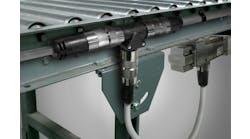Jim Montague is the executive editor for Control, Control Design and Industrial Networking. Email him at [email protected].
Just because some circuits carry less juice doesn't mean they don't need and deserve protection. In fact, 24-V and other lower-power circuits are proliferating in devices and networks, and so are the tools and smarts to safeguard them. As always, the trick is to apply them appropriately for the most benefit.
"Circuit protection is a mainstay of 24-V products, but besides breakers and fuses, we have increasing use of electronic circuit protection (ECP) software and intelligence," says Aaron Henry, North American market manager for Murrelektronik. "This is because breakers and fuses don't always work as well as they should when protecting low-voltage.
Breakers and fuses are older technologies, Henry reminds us. They look for heat to identify current-resistance and other problems, and they have to be replaced frequently. "However, electronic circuit protection can be turned on and off remotely, it keeps people out of potentially hazardous cabinets, monitors entire circuit current levels, handles current inrushes better and immediately notifies users of short circuits without having to go through the usual breaker conditions of resistance and heat. ECP is really the next generation of breaker and fuse functions," he says.
Over the 10 years Murrelektonik has been building ECP devices, Henry reports, it's expanded into broader current and voltage levels, and developed its Mico products, which are similar in shape to breakers, have adjustable current settings and can replace 12 traditional breaker styles. The latest Mico product is a 48-Vdc solution. "The microprocessor and software in an ECP component monitors current, and as its panel approaches 90% of a pre-selected current level, it gives a warning. If the current goes beyond that level, it reports if there's a fault or overload condition, isolates that circuit and cuts the voltage. ECP is a relatively new technology, so we're excited to bring these new products to market with more functionality."
Traditional breakers can monitor for short circuits or over-current conditions, but not both. However, ECP can perform both tasks. "Many circuits are getting more sophisticated and becoming involved with higher-level fieldbuses, and ECP capabilities can assist these changes, which is improving its acceptance," Henry adds. "In the U.S. markets, we still have a lot of education to do, but there's a clear trend to toward avoiding contact with potentially hazardous cabinets and removing consumable components from inside them. Everyone is becoming more aware that they need circuit protection at low-voltage levels."
Also Read: Industrial Sensors Offer More Connectivity Options
Mark Stremmel, U.S. systems manager for Turck's Engineered Packaged Systems group, adds that, "Old-school system design and circuit protection was regimented and strict, and we used circuit breakers on the load side of the 24-V supply and on the line side as well, so users could isolate power, test and do maintenance. Breakers would be distributed for all PLCs and HMIs, but as OEMs competed more, many no longer did it because it wasn't required by UL508A."
Stremmel adds that almost all dc power supplies have gained some form of electronic short-circuit protection built into their circuitry over the past 10 to 15 years. "If they read an over-power or short circuit condition, then the output side shuts down until the load or short is removed," he explains. "However, because of this electronic monitoring and protection, many users and OEMs now think they don't need circuit breakers as much on the load side."
While most control systems and circuits also migrated from 120 Vac to 24 Vdc during the same 10 to 15 years, Stremmel reports Turck believes breakers are still essential in many settings. Turck offers circuit protection in all its I/O product categories, including on-machine block, on-machine modular, in-panel block I/O and in-panel modular, which all communicate via multiple Ethernet-based protocols.
"Our view is that if you've got a PLC, HMI, Ethernet switch or other dc device such as field power, then you don't want all of them to go down when one shorts out," Stremmel says. "Consequently, a breaker and fuse might be needed ahead of each component, but you also begin to get into a question of economics versus convenience. More breakers can help keep a system running, but most users probably can't afford so many of them. Some users might want a breaker at every I/O point to disconnect power from the field and aid maintenance, but today this can be seen as overkill. It just depends what market you're in, such as packaging machinery or material handling, and how much they need to drive prices down. They'll analyze more closely where they need circuit protection, add fewer where it's used for connection convenience, but keep all their breakers in safety areas."
Jerry Watkins, business team leader for power components at Rockwell Automation, reports that circuit protection has gone beyond shielding individual wires, motors and other parts to protecting all-in-one devices more affordably. "Breakers are gaining more sophisticated electronics, so they can do several functions in one device or enable trip settings, so people can work with them more safely," Watkins says. "Customers also demand higher-rated protection, so we're focusing on testing controls, circuit boards and related devices together as complete systems."
Watkins adds that Rockwell launched its 140G circuit breakers in February, which are intended for global applications and carry multiple certifications from UL, IEC and others. "These breakers can be tested and certified to comply with different standards because the small spacings between their phases are adjustable, which allows them to meet the current ratings and voltage ratings required by the North American and international standards organizations."
Besides benefitting from ECP's intelligence, many newer circuit breakers or other replacement modules are further protected by molded casings and are configured so they can take the places of earlier, consumable counterparts. "We're able to exchange our trip units with core breakers to maintain UL certifications," adds Watkins.





